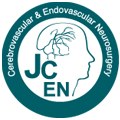- Apply for Authority
- P-ISSN2234-8565
- E-ISSN2287-3139
 ISSN : 2234-8565
ISSN : 2234-8565
Internal maxillary artery (IMax) – middle cerebral artery bypass in a patient with bilateral atherosclerotic carotid occlusion: A technical case report
Casas-Martínez Martin R. (Vascular Neurosurgery Department, National Institute of Neurology and Neurosurgery “Manuel Velasco Suárez”, Mexico City, Mexico)
Mejia Bill Roy Ferrufino (Vascular Neurosurgery Department, National Institute of Neurology and Neurosurgery “Manuel Velasco Suárez”, Mexico City, Mexico)
Balcázar-Padrón Juan C. (Vascular Neurosurgery Department, National Institute of Neurology and Neurosurgery “Manuel Velasco Suárez”, Mexico City, Mexico)
Rodríguez-Rubio Héctor A. (Vascular Neurosurgery Department, National Institute of Neurology and Neurosurgery “Manuel Velasco Suárez”, Mexico City, Mexico)
Nathal Edgar (Vascular Neurosurgery Department, National Institute of Neurology and Neurosurgery “Manuel Velasco Suárez”, Mexico City, Mexico)
- Downloaded
- Viewed
Abstract
Since the first description of the possible utilization of the internal maxillary artery for bypass surgery, there are some reports of its use in aneurysm cases; however, there is no information about the possible advantages of this type of bypass for cerebral ischemic disease.We present a 77-year-old man with a history of diabetes, hypertension, systemic atherosclerosis, and two acute myocardial infarctions with left hemiparesis. Imaging studies reported total occlusion of the right internal carotid artery and 75% occlusion on the left side, with an old opercular infarction and repeated transient ischemic attacks in the right middle cerebral artery territory despite medical treatment. After a consensus, we decided to perform a bypass from the internal maxillary artery to the M2 segment of the middle cerebral artery using a radial artery graft. After performing the proximal anastomosis, the calculated graft’s free flow was 216 ml/min. Subsequently, after completing the bypass, the patency was confirmed with fluorescein videoangiography and intraoperative Doppler. Postoperatively, imaging studies showed improvement in the perfusion values and the hemiparesis from 3/5 to 4+/5. The patient was discharged one week after the operation, with a modified Rankin scale of 1, without added deficits.The use of revascularization techniques in steno-occlusive disease indicates a select group of patients that may benefit from this procedure. In addition, internal maxillary artery bypass has provided a safe option for large areas of ischemia that cannot be supplied with a superficial temporal artery - middle cerebral artery bypass.
- keywords
- Cerebral revascularization, Maxillary artery, Brain ischemia, Carotid artery stenoses, Carotid atherosclerosis, IMax bypass
- Downloaded
- Viewed
- 0KCI Citations
- 0WOS Citations
